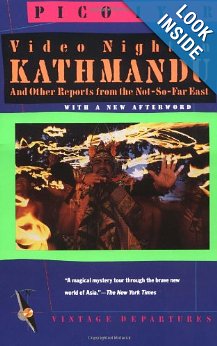Introduction
These slides are tied to our first reading of Arjun Appadurai's “Disjuncture and Difference in the Global Cultural Economy.” The full chapter appears as pages 94-103 in the 5th editon of our texbook.
The proper pronunciation of Appadurai's last name is close to "uh-PAH-dur-eye," with the accent on the second syllable. Information about his past and present work is available on his web site.
Although Appadurai's writing style is more concrete and approachable than that of many theorists, your understanding of his work will still benefit from a reference like dictionary.com.
Like King, Appadurai is investigating the meanings of a fundamental transformation (95)
For with the advent of the steamship, the automobile, the airplane, the camera, the computer, and the telephone, we have entered into an altogether new condition of neighborliness, even with those most distant from ourselves.
[Notice that these are all technologies of transporation or communication.]
A summary of Appadurai's central point
[I]f a global cultural system is emerging, it is filled with ironies and resistances... (96).
However, unlike King and Marshall McLuhan, Appadurai doesn't think that the world is becoming a single "neighborhood" (King) or a single "village" (McLuhan).
For Appadurai, the story of globalization is not a simple story of homogenization.
Pico Iyer and the "Not so far East"
On 95-96 Appadurai references Pico Iyer's book Video Night in Kathmandu: And Other Reports from the Not-So-Far East.
 Iyer's thesis is that East Asia in the 1980s is not a place of alien or exotic cultures. Instead, in each chapter Iyer relates his travels in a different country, where he meets a thoroughly globalized, cosmopolitan population that borrows as it chooses from Western cultures.
Iyer's thesis is that East Asia in the 1980s is not a place of alien or exotic cultures. Instead, in each chapter Iyer relates his travels in a different country, where he meets a thoroughly globalized, cosmopolitan population that borrows as it chooses from Western cultures.
In one chapter, "The Philippines: Born in the U.S.A.," Iyer discusses the widespread ability of Filipinos to mimic the vocal and physical identities of Western singers and stars.
This is not Whitney Houston
This is really not Whitney Houston
 Through this example, Appadurai wants to challenge the notion that globalization is synonymous with Westernization or Americanization - the idea that Filipinos love old American pop standards because they want or need to follow in our footsteps.
Through this example, Appadurai wants to challenge the notion that globalization is synonymous with Westernization or Americanization - the idea that Filipinos love old American pop standards because they want or need to follow in our footsteps.
This is a frequent error that Westerners fall into. We imagine that modern = Western and that Others are following behind us on the path toward the future. Many Westerners feel, therefore, that what Others most desire is to "catch up," so they can become more Western (i.e. more modern). This is wrong.
Filipinos do love to sing old U.S. songs, but not because they are living through a version of America's past. In fact, the Filipino present is quite different than the American past. The Filipinos have embraced retro American music for their own purposes, and the music functions quite differently there than it did here.
Indigenization
In fact, the young woman singing Whitney Houston is a good example of indigenization, a key term for our class that Appadurai introduces here (96).
What these arguments fail to consider is that at least as rapidly as forces from various metropolises are brought into new societies they tend to become indigenized in one or another way.
Indigenization and hybridity
 As the example of Filipino music culture demonstrates, indigenization often results in hybrids, which is another key term that will appear in later readings.
As the example of Filipino music culture demonstrates, indigenization often results in hybrids, which is another key term that will appear in later readings.
Hybrids and the resulting state of hybridity occur when influences from two or more different cultures are combined to create some new thing.
In this case, we should recognize that Filipinos have created a new and unique musical culture by mixing together diverse practices (like Japanese karaoke) and content (like U.S. pop songs).
Later we will consider other practices that result in cultural hybridity, including South Korean popular music and the food culture of Hong Kong.
The “Scapes”: five global flows
In Appadurai's book, this chapter begins a section called "Global Flows." In this excerpt Appadurai identifies the things that are flowing around the globe: people, technology, money, media, and ideas.
These can be described as five interrelated, yet relatively autonomous "scapes":
- ethnoscapes (i.e. flows of people)
- technoscapes (i.e. flows of technologies)
- financescapes (i.e. flows of money)
- mediascapes(i.e. flows of media)
- ideoscapes (i.e. flows of ideas)
Scapes: ethnoscapes
The two flows that are doing the most to change the world, Appadurai argues, are the movements of people (ethnoscapes) and media (mediascapes). These links provide information about global migration.
- UN global migration statistics 2019: Note that the U.S. is the most affected country in terms of the total number of migrants, but that Europe is the largest region.
- CIA Net Migration: This is a important corrective to the chart above. Focusing only on raw numbers overstates the relative impact of migration on U.S. culture. As a percentage of their population, many other countries are experiencing a larger impact.
Using the scapes to "imagine worlds"
Appadurai chose to call these "scapes" to point toward the ways that these constant flows of people, money, technology, media, and ideas are experienced by individuals and small communities.
Appadurai argues that, from the point of view of any particular individual, these flows of people, money, etc. feel like stable landscapes (97). They are the "building blocks" that individuals and groups use to create the "imagined worlds" that they use to make sense of their lives (98).
In fact, however, these worlds are in constant flux; they are the products of 24/7 flows with unprecedented scope and range.
“Imagined Communities” require “Constructed Ethnicities”
Appadurai extends Benedict Anderson's concept of "imagined communities," particularly stressing the ways that globalization simultaneously produces "constructed ethnicities." For example, during colonization, learning English made many Indians feel "British" in a way they had not felt before. At the same time, though, confronting the Other and learning his language also made many feel "Indian" (or "Hindu," or "Tamil," etc.) in ways that they also had not felt before (96).
This leads to one of Appadurai's fundamental insights: We err to the extent that we imagine ethnic identities to be expressions of the past rather than the present. Islamic fundamentalism, for example, is not a holdover or return to past ways of thinking. It is an "ideoscape" produced and sustained by the global systems of the 21st century (cf 99).
